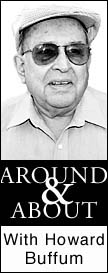

They play year-around, and Larry Schuster, one of the original group, said that as far as the weather is concerned, "We have a 30-degree limit, though we have played when it was 28." And many times they've had to mop off the court before they could play.
 "For the first few years when the weather was bad, we played racquetball
at the country club," Larry added. "But finally we were discouraged
from playing there because only one of our group was a member."
"For the first few years when the weather was bad, we played racquetball
at the country club," Larry added. "But finally we were discouraged
from playing there because only one of our group was a member."
All four arrive at the courts rather promptly at 6:30 a.m. ("a little later if it's still dark," says Larry) and they play until 8 or 8:30. Not all dress as tennis pros. In fact, Larry's wife, Kathryn, says, "Larry's no fashion plate for tennis attire. As long as he covers up his legs, the boys are happy."
At 53, Allan Jones is "the kid" of the group. He commented, "I didn't know if I wanted to continue playing with those old guys, but I'm still at it."
Those "old guys," besides Larry who's 66, are Bob Kearns, also 66, and Les Hogue, who's 64. Les offered the observation that "sometimes it's hard to recognize the game as tennis."
The original group included Leonard Richardson who played for some 25 years until four and a half years ago when, after knee surgery, his doctor advised him to give it up. That's when Allan joined the group full time
Larry is with Schuster's Yard & Garden Center. Bob runs Bob's True Value store. Les is territory manager with Metals USA of Wichita, and Allan has been with ATS in Wichita for several years after 32 years with the former Binney & Smith Winfield plant.
(Column note: Many thanks to Kathryn Schuster for braving the early hour to snap the photo.)
Indian trail - An article in the June 8, 1910, edition of the Courier tells about the heavily traveled Indian trail which passed through the Walnut Valley prior to the settling of Winfield. "Coming up by various ways through the Indian nations, the trail converged in the vicinity of Tulsa and came northwest from there to the lower part of the Walnut Valley .... passed over the site of Winfield, crossing the Walnut at the ford south of town and Timber Creek at the ford north of Island Park. It was nearly on what is now Manning Street, a little east of it .... it then kept along the Walnut to the vicinity of Augusta where it bent to the northwest and went by the present site of Wichita to join the Santa Fe trail near Great Bend."
Precious memorabilia - In all my interviews of interesting people I have come to one conclusion: There is a museum in every home. But, sadly, many times such precious material ultimately is not saved.
I was reminded of this recently by an article in a Nov. 11 edition of the Orlando (Fla.) Sentinel. It said, in part: "Every day, bits of history become garbage. The letters, diaries, photographs and journals of war veterans are disappearing as fast as the veterans themselves pass away."
"So much is being lost every day," said Bill Oldson, a Florida State University history professor. "What we are finding is the vast majority are being thrown away or stored where they decay."
Oldson is director of the Institute on World War II and the Human Experience, where many of its 2,500 items were found in trash piles, curb gutters, garage sales and flea markets. What others see as irrelevant junk, trash and clutter, Oldson recognizes as eyewitness testimony to the everyday lives of people at war. "This stuff on paper reflects the social history of the time," Oldson said. "It gives us a better grasp of how people got through the war, not only physically, but spiritually, intellectually and emotionally."